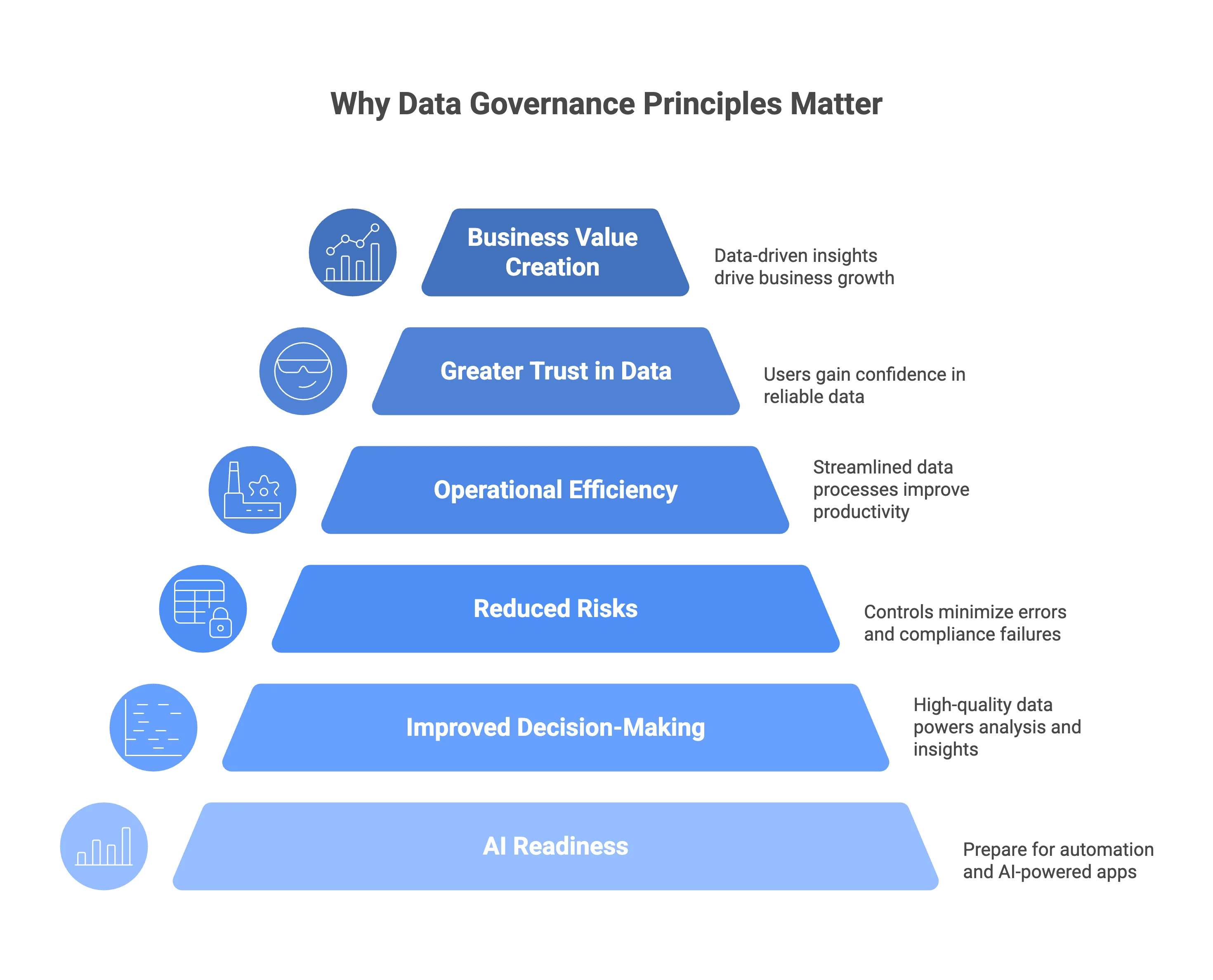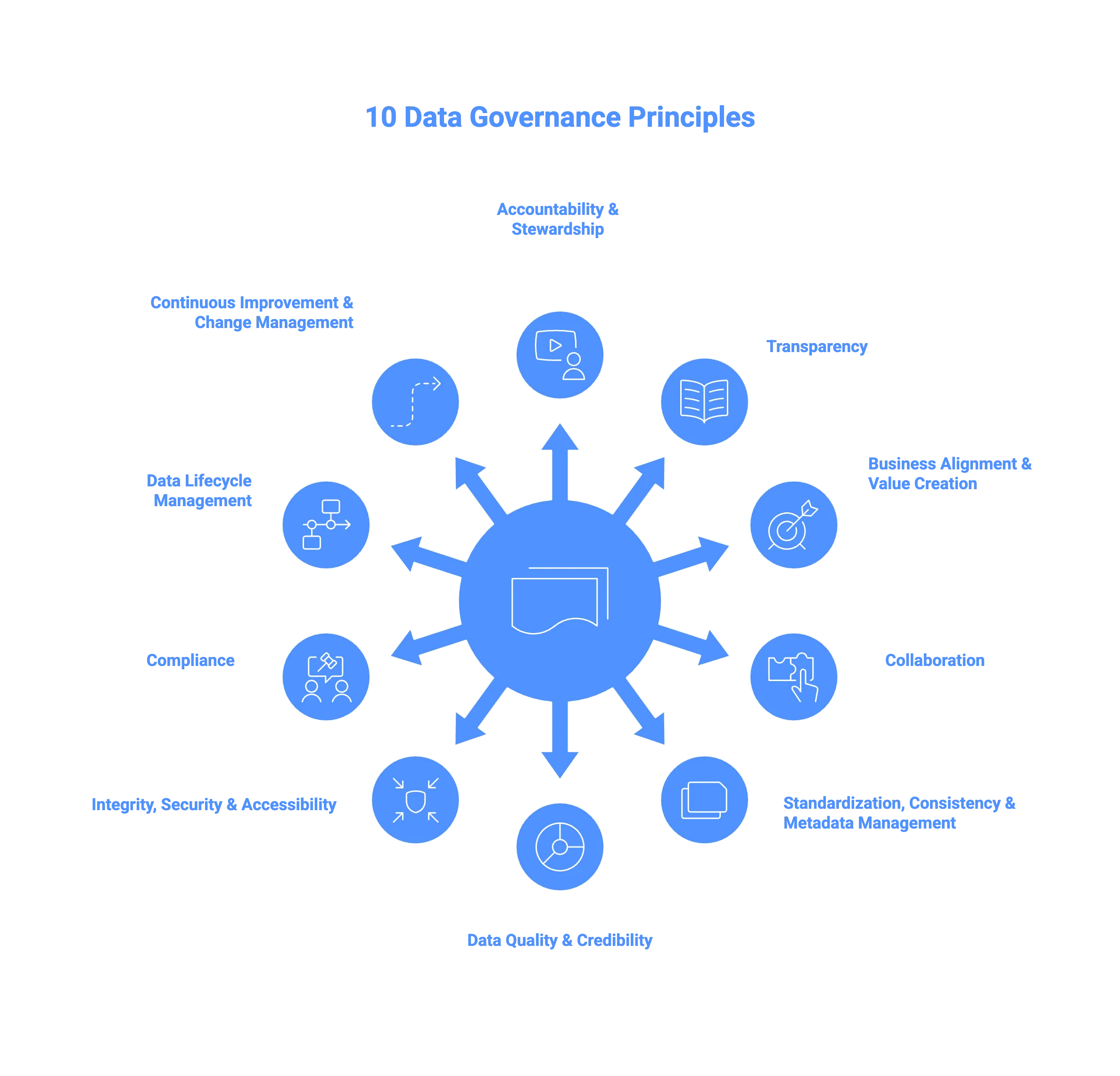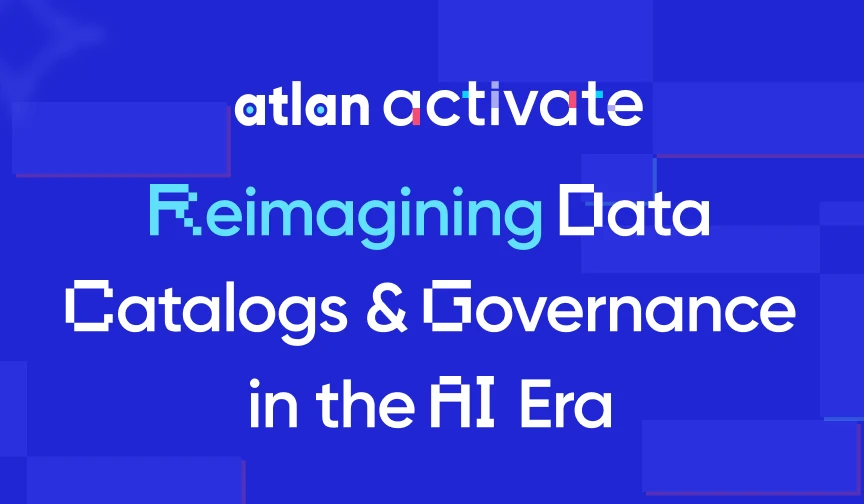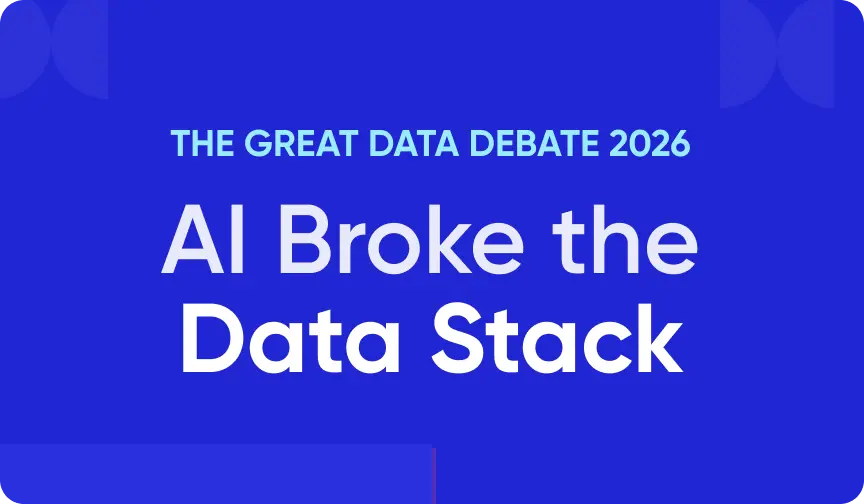10 Foundational Data Governance Principles in 2025 That Every Leader Must Know
Why are data governance principles important?
Permalink to “Why are data governance principles important?”Summarize and analyze this article with 👉 🔮 Google AI Mode or 💬 ChatGPT or 🔍 Perplexity or 🤖 Claude or 🐦 Grok (X) .
Data governance principles act as the compass for every governance program. Without them, policies become reactive and inconsistent. By embedding principles into operations, organizations achieve:
- Improved decision-making: High-quality, trustworthy data powers analysis and insights.
- Reduced risks: Better controls minimize errors, fraud, and compliance failures.
- Operational efficiency: Streamlined data processes improve productivity.
- Greater trust in data: Users gain confidence in the data they rely on.
- Business value creation: Data becomes a strategic asset for innovation and growth.
- Regulatory compliance: Principles ensure adherence to GDPR, HIPAA, BCBS 239, and other frameworks.
- AI readiness: Metadata and standardization prepare data estates for automation and intelligent applications.

Reasons why data governance principles matter - Image by Atlan.
What are the ten foundational data governance principles?
Permalink to “What are the ten foundational data governance principles?”The ten foundational data governance principles form the bedrock of a sustainable data governance program. They establish the culture, strategic alignment, and structural guardrails that make governance stick across the enterprise.

10 data governance principles - Image by Atlan.
1. Accountability and stewardship
Permalink to “1. Accountability and stewardship”Every dataset needs clear ownership. Data owners hold ultimate responsibility, while data stewards translate policies into practice by monitoring quality, maintaining metadata, and enforcing compliance. This principle ensures no data asset is left unmanaged.
2. Transparency
Permalink to “2. Transparency”Governance must be understandable. Documenting processes, publishing standards, and making policies accessible ensures all stakeholders know how data is being managed and why decisions are being made.
3. Business alignment and value creation
Permalink to “3. Business alignment and value creation”The ultimate measure of governance success is business impact. Data governance should enable new opportunities—like faster insights, reduced costs, or regulatory protection—so it’s seen as a growth driver rather than red tape.
For this purpose, governance principles should directly connect to business strategy and mandate measurable business outcomes, such as improved customer experience, faster reporting, or reduced operational costs.
4. Collaboration
Permalink to “4. Collaboration”Governance is a team effort. IT, business units, compliance, legal, and analytics teams need to work together, share accountability, and align on priorities. This principle prevents silos, accelerates adoption, and embeds governance into everyday workflows.
5. Standardization, consistency & metadata management
Permalink to “5. Standardization, consistency & metadata management”Without consistency in formats, definitions, and metadata, governance quickly breaks down. This principle enforces standard business glossaries, consistent taxonomies, and active metadata management, which are essential for discovery, lineage tracking, and AI readiness.
6. Quality & credibility
Permalink to “6. Quality & credibility”Data must be accurate, complete, timely, and reliable to be trusted. This principle establishes processes like data profiling, validation rules, and continuous monitoring, ensuring data supports informed decisions and regulatory reporting.
7. Integrity, security & accessibility
Permalink to “7. Integrity, security & accessibility”Governance should balance protection with usability. Data must remain secure from unauthorized access or breaches, yet still accessible to those with legitimate business needs. Strong encryption, role-based access, and audit trails embody this principle.
8. Compliance
Permalink to “8. Compliance”Complying with laws, regulations, and industry standards (such as GDPR, HIPAA, or BCBS 239) reduces legal, financial, and reputational risks. This principle ensures governance frameworks remain defensible and aligned with evolving regulatory landscapes.
9. Lifecycle management
Permalink to “9. Lifecycle management”Data must be managed from its creation to archival or deletion. Proper lifecycle oversight prevents storage bloat, reduces compliance exposure from stale data, and ensures data remains relevant and cost-effective throughout its journey.
10. Continuous improvement & change management
Permalink to “10. Continuous improvement & change management”Governance frameworks must evolve alongside shifting business priorities, technologies, and regulations.
This principle ensures that policies, standards, and rules are regularly reviewed and updated to reflect emerging laws (like GDPR updates or AI governance acts), new internal needs, and advances in data platforms.
Embedding structured change management helps organizations adapt smoothly, while regulatory awareness ensures compliance doesn’t lag behind.
What are the three operational enablers of data governance principles?
Permalink to “What are the three operational enablers of data governance principles?”The ten foundational data governance principles listed above set the culture and guardrails for governance.
But to make them practical, organizations need operational enablers — the day-to-day mechanisms, systems, and technologies that bring principles to life. These enablers ensure that governance is embedded in workflows rather than existing only in policy documents.
These include:
- Governance tooling: Modern governance platforms integrate cataloging, data quality, lineage, access control, and policy management in one place. Such unified governance systems reduce overhead and provide a single source of truth for compliance, discovery, and stewardship.
- Architecture: A well-designed data architecture ensures scalability, interoperability, and secure data flow. This includes defining how data is stored, integrated, accessed, and retired across cloud, on-prem, and hybrid environments. Architectural clarity enables organizations to enforce governance at every stage of the lifecycle.
- Metadata-driven automation: Metadata is the connective tissue of modern governance. By capturing technical, business, and operational context, metadata powers automated classification, lineage, policy enforcement, and access controls. Active metadata — continuously refreshed and exchanged across systems — allows governance to scale, cuts manual overhead, and makes AI-readiness possible.
Together, governance tooling, architecture, and metadata-driven automation ensure that data governance principles don’t remain static ideals but become embedded in daily workflows.
These enablers scale governance across complex ecosystems and lay the groundwork for AI-readiness.
How is AI reshaping data governance principles?
Permalink to “How is AI reshaping data governance principles?”As organizations integrate AI into their operations, governance principles must evolve.
Most importantly, it amplifies the importance of metadata. Without rich, accurate, and active metadata, AI models cannot discover data, contextualize it, or explain their outcomes.
The five data governance principles that become essential for an AI-ready data estate are:
- Solid metadata foundation: AI depends on metadata to understand what data exists, where it comes from, how it has changed, and whether it’s trustworthy. Without this context, AI insights risk being opaque, biased, or misleading.
- Automation of principles: Rules for quality, compliance, and lifecycle management can now be codified into systems that apply them in real time.
- Bias and fairness: Governance principles around transparency and accountability now extend to the datasets and features used in AI models. Metadata must capture these details for explainability.
- Explainability: Metadata provides the audit trail—lineage, tags, policies—that makes AI outputs understandable and defensible to regulators, auditors, and business users.
- AI governance: A new layer of governance is emerging, where metadata links data policies, model inputs, and outputs into one continuous oversight framework.
What tools do you need to follow data governance principles in practice?
Permalink to “What tools do you need to follow data governance principles in practice?”Data governance principles only work if they’re operationalized with the right tools. Traditional toolsets (catalogs, quality dashboards, compliance trackers) often exist in silos, creating inefficiencies.
Modern teams need a unified, metadata-driven control plane like Atlan that brings these principles to life by enabling:
- Policy enforcement: Admins set rules once; Atlan auto-applies them across sources with live compliance dashboards.
- Contextual quality management: Stewards trace lineage, tag sensitive data, and monitor quality KPIs in one place.
- Security & compliance monitoring: Custodians manage encryption, access, and audit logs via API integrations.
- Self-service discovery: Business users search, request, and explore trusted datasets through a Google-like interface.
Teams that consolidate onto Atlan see 35% faster time-to-insight and 40% lower governance overhead because policies, lineage, quality checks, and collaboration all run through one shared workspace.
Real stories from real customers: Embedding data governance principles at scale
Permalink to “Real stories from real customers: Embedding data governance principles at scale”
Democratized trusted data across Elastic using Atlan
“For Elastic’s data governance principles, Atlan was really the only one that truly met all their needs. For instance, using Atlan’s Chrome Plug-in, relevant context is available in dashboards directly. During pipeline breakages, Atlan helps instantly identify all assets impacted downstream. Atlan’s popularity metrics are a guide to understanding what data is relevant and appropriate. Atlan also helps keep a close eye on data quality for critical fields.”
Takashi Ueki, Director of Enterprise Data & Analytics
Elastic
🎧 Listen to podcast: Elastic, a legendary technology company
Discover how a modern data governance platform drives real results
Book a Personalized Demo →
Modernized data stack and launched new products faster while safeguarding sensitive data
“Austin Capital Bank has embraced Atlan as their Active Metadata Management solution to modernize their data stack and enhance data governance. Ian Bass, Head of Data & Analytics, highlighted, ‘We needed a tool for data governance… an interface built on top of Snowflake to easily see who has access to what.’ With Atlan, they launched new products with unprecedented speed while ensuring sensitive data is protected through advanced masking policies.”

Ian Bass, Head of Data & Analytics
Austin Capital Bank
🎧 Listen to podcast: Austin Capital Bank From Data Chaos to Data Confidence
Ready to embed data governance principles?
Permalink to “Ready to embed data governance principles?”Data governance principles are the cultural, operational, and strategic anchors of how your organization manages data.
They create a shared language for councils, teams, and business stakeholders, ensuring data is managed responsibly and used to deliver measurable business value.
By embedding them into daily practices, you ensure data remains accurate, secure, and trusted—even as AI, regulations, and business priorities evolve.
Are you ready to embed these principles into your data culture and realize them in practice?
Discover how a modern data governance platform drives real results
Book a Personalized Demo →FAQs about data governance principles
Permalink to “FAQs about data governance principles”1. What are data governance principles?
Permalink to “1. What are data governance principles?”Data governance principles are the core rules and guidelines that define how organizations manage, secure, and use data. They ensure that data remains accurate, compliant, and valuable across its lifecycle.
2. What are the ten principles of data governance?
Permalink to “2. What are the ten principles of data governance?”The ten principles of data governance include accountability, transparency, business alignment, collaboration, quality, integrity, compliance, metadata management, lifecycle management, and continuous improvement.
3. Why are data governance principles important?
Permalink to “3. Why are data governance principles important?”They provide structure and accountability, enabling better decision-making, reducing compliance risks, protecting sensitive data, and building trust in organizational data assets.
4. Who defines and enforces data governance principles?
Permalink to “4. Who defines and enforces data governance principles?”Typically, the data governance council sets the principles, while the data governance team enforces them in daily workflows through policies, stewardship, and technology.
5. How do data governance principles support AI and advanced analytics?
Permalink to “5. How do data governance principles support AI and advanced analytics?”By ensuring high-quality, well-documented, and metadata-rich data, governance principles make AI models more accurate, explainable, and compliant with regulatory expectations.
6. What tools help organizations implement data governance principles?
Permalink to “6. What tools help organizations implement data governance principles?”Metadata-driven control planes like Atlan bring cataloging, lineage, quality, and access control into one platform, ensuring principles are embedded into everyday workflows.
7. How do principles differ from policies?
Permalink to “7. How do principles differ from policies?”Principles provide the overarching philosophy or “why” behind governance, while policies translate them into actionable “how” — specific rules and procedures for teams to follow.
Share this article
Atlan is the next-generation platform for data and AI governance. It is a control plane that stitches together a business's disparate data infrastructure, cataloging and enriching data with business context and security.
Data governance principles: Related reads
Permalink to “Data governance principles: Related reads”- Data governance and its importance in the modern data stack
- 6 commonly referenced data governance frameworks in 2025
- 8 best practices for a robust data governance program
- Objectives and goals of data governance: Data democratization & data security
- Data governance policy: Examples, templates & how to write one
- Data Catalog: Does Your Business Really Need One?























